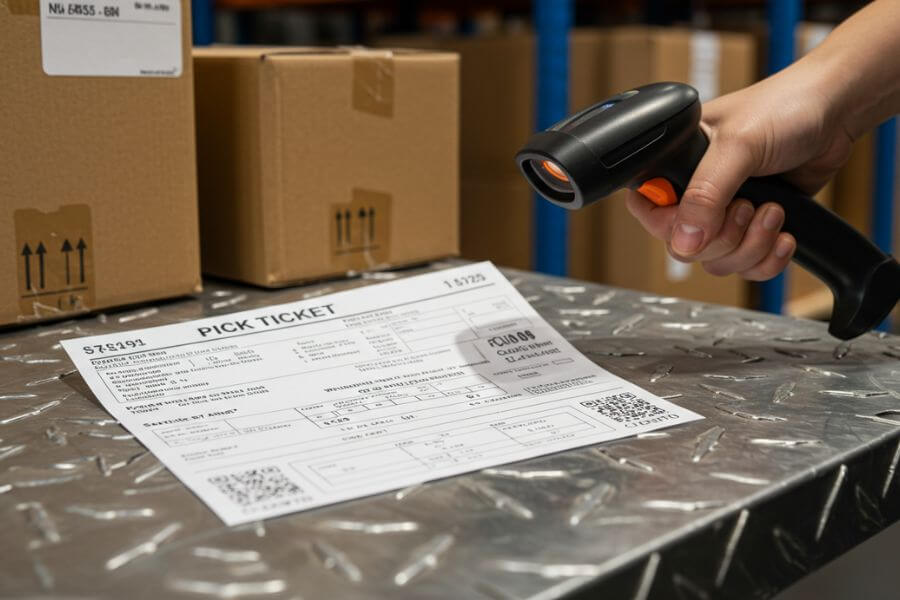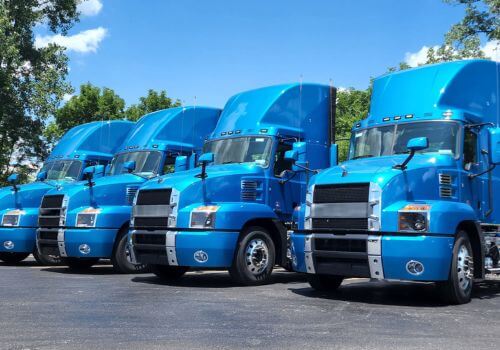In logistics and warehouse management, precision and speed are essential. From the moment a customer places an order to the point it’s delivered to their doorstep, there are many steps that must align seamlessly. One of the most critical but often underestimated tools in this process is the pick ticket.
Think of the pick ticket as the bridge between digital orders and physical products. It’s the document that ensures the right items are picked, in the right quantities, and sent to the right place. In this guide, we’ll explore everything you need to know about pick tickets, including what they are, how they work, the different types, common mistakes, and how to use them more effectively.
What is a pick ticket?
A pick ticket is a document used in warehouse operations to guide staff in collecting items for customer orders. It functions like a shopping list for warehouse pickers, telling them what items to pick, how many, and where each one is stored within the facility. This document is generated when an order is received and processed by the warehouse management system (WMS).
Pick tickets can be physical printouts or digital records accessible via handheld devices like barcode scanners or tablets. They help warehouse workers complete their tasks more efficiently by giving them all the essential details in one place. While the concept is simple, the impact on operations is significant. Without pick tickets or an alternative system performing the same role, orders would be slower to fulfill and more prone to error.
Why are pick tickets important in logistics?
Although small in size, pick tickets carry a lot of weight in the logistics chain. They play a central role in ensuring that customer orders are fulfilled accurately, efficiently, and on time. Here are some key reasons why they’re essential:
- Error prevention: A well-organized pick ticket makes it easy to identify and retrieve the correct products. This reduces the likelihood of shipping incorrect or incomplete orders, which can be costly in terms of both time and customer trust.
- Operational efficiency: By clearly indicating item locations and required quantities, pick tickets help minimize time spent searching for products. This leads to faster picking, shorter order cycle times, and improved productivity.
- Inventory control: Pick tickets are often integrated with inventory management systems. As items are picked, inventory levels are updated automatically or manually, ensuring accurate stock levels and reducing the risk of stockouts or overstocking.
- Customer satisfaction: Orders that are picked accurately and shipped on time enhance the customer experience. Delays or mistakes due to poor picking practices can damage reputation and hurt repeat business.
Whether you’re running a small fulfillment center or a large distribution hub, using pick tickets effectively is a fundamental part of delivering excellent service.
What's included in a pick ticket?
Pick tickets can vary in layout depending on the warehouse management system or company preferences, but they generally contain the following key components that make it easy for pickers to retrieve the correct items and reduce the risk of mistakes.
Order number
This unique identifier ties the pick ticket to a specific customer order. It helps track the order’s progress throughout the picking, packing, and shipping process.
Customer details
Typically includes the recipient’s name and shipping address. Some tickets may also include contact information in case verification is needed before dispatch.
Itemized product list
The heart of the pick ticket. Each item usually includes:
- Product name or description
- SKU or item code
- Quantity to be picked
- Unit of measurement
Location information
Indicates exactly where each item is stored within the warehouse. This might include aisle numbers, shelf designations, bin numbers, and warehouse zones.
Special handling notes
This section highlights important instructions such as “fragile,” “keep refrigerated,” “hazardous,” or “lot number required.” These notes ensure that items are handled appropriately.
Barcodes or QR codes
Many modern pick tickets include scannable codes for fast, error-free item verification and inventory tracking.
How does pick tickets fit into the fulfillment workflow?
Understanding where pick tickets come into play within the order fulfillment process helps illustrate their importance. Here’s a step-by-step overview:
- Order received: A customer places an order via a website, retail partner, or internal sales system. This order is sent to the warehouse’s order management system.
- Order translated into a pick ticket: The system generates a pick ticket that includes all the necessary picking information. This could be a printed document or a digital version sent to a mobile device.
- Picking process begins: A warehouse employee uses the pick ticket to gather all items required for the order. This involves navigating the warehouse based on location details provided.
- Picked items verified and packed: Once all items are gathered, they’re taken to the packing area. Here, the order is checked for accuracy, packed securely, and labeled for shipment.
- Shipping and inventory update: The order is handed over to the carrier. Inventory levels are updated based on what was picked, closing the loop on the fulfillment process.
The pick ticket essentially guides steps three and four, ensuring the picker retrieves the right items in the correct quantities.
What are the differences between paper and digital pick tickets?
Both paper and digital pick tickets are used in modern warehouses, and each comes with its pros and cons.
Paper pick tickets
Pros:
- Easy to implement, especially in smaller operations
- Don’t require special technology or infrastructure
- Can be used in environments with limited connectivity
Cons:
- Easy to misplace or damage
- No real-time inventory updates
- Higher likelihood of human error
- Slower performance tracking and auditing
Digital pick tickets
Pros:
- Real-time data and inventory synchronization
- Reduces errors through barcode or RFID scanning
- Enables detailed tracking and analytics
- Can be integrated with automation systems
Cons:
- Requires investment in technology and training
- May require stable network infrastructure
- Needs ongoing software maintenance
Most growing warehouses eventually move to digital systems to enhance accuracy and streamline operations, but paper pick tickets are still widely used where simplicity and cost-effectiveness are priorities.
What are the different types of picking methods supported by pick tickets?
How a pick ticket is structured often depends on the picking method a warehouse uses. Different fulfillment strategies call for different types of pick tickets.
Discrete order picking
Each picker is responsible for completing one order at a time. The pick ticket reflects just one customer’s order, making it easy to track and verify.
Advantages: Simple and highly accurate.
Best used in: Low-volume operations or where orders vary widely.
Batch picking
Multiple orders are grouped together by SKU. The picker collects all units of a single SKU at once for multiple orders.
Advantages: Reduces walking time and increases efficiency.
Best used in: High-volume operations with many small orders.
Zone picking
The warehouse is divided into zones, and each picker is responsible for one zone. The pick ticket is segmented accordingly.
Advantages: Efficient for large warehouses. Reduces congestion and walking.
Best used in: Warehouses with a large footprint or multiple product categories.
Wave picking
Orders are released in waves based on criteria such as shipping deadlines or carrier pickup times. Combines aspects of batch and zone picking.
Advantages: Maximizes efficiency based on priority.
Best used in: Time-sensitive operations and complex fulfillment environments.
Understanding which method suits your operation helps you design the right kind of pick ticket for optimal results.
What are some common mistakes and how can you avoid them?
Mistakes in order picking can lead to shipping delays, returns, and customer complaints. Here are common issues that arise when using pick tickets—and how to avoid them:
- Wrong SKU picked: It’s easy to confuse similar-looking products. Always verify the SKU and description.
- Incorrect quantity: Grabbing too few or too many of an item can cause problems downstream. Double-check quantities and use counters or scanners.
- Items omitted: Skipping a line item by accident is a common oversight. Mark off items clearly or use digital checklists.
- Ignoring instructions: Special instructions like “cold storage” or “fragile” are sometimes overlooked. Make these notes prominent on the ticket.
- Outdated pick tickets: Using a ticket that doesn’t reflect real-time stock can lead to picking unavailable items. Always ensure you’re working with the latest version.
Reducing these errors improves efficiency and customer satisfaction.
What are the best practices for using pick tickets?
To get the most out of your pick ticket process, consider these practical tips:
1. Organize pick paths logically
Arrange pick tickets so they follow a path through the warehouse that minimizes walking. Some systems automatically sort by location.
2. Prioritize high-volume items
Store popular items closer to packing areas to reduce retrieval time.
3. Invest in scanning tools
Barcode or QR scanning increases speed and reduces mistakes, especially when combined with digital pick tickets.
4. Provide regular training
Train staff not only on how to read pick tickets but also on warehouse layout and tools. Even experienced pickers benefit from periodic refreshers.
5. Use feedback loops
Encourage pickers to report errors, inconsistencies, or confusing layouts on pick tickets so the process can be improved.
These strategies help build a faster, smarter, and more accurate fulfillment system.
Frequently asked questions about pick tickets
Q1. What is the difference between a pick ticket and a packing slip?
A1. A pick ticket is used by warehouse staff to locate and collect items for an order, while a packing slip is included in the shipment and shows the customer what items are inside the package.
Q2. Can pick tickets be used for partial orders?
A2. Yes, pick tickets can be generated for partial orders if some items are out of stock or shipped from different locations. The system usually updates the ticket to reflect only the available items.
Q3. Do I need a warehouse management system to generate pick tickets?
A3. Not necessarily. While a WMS automates the process, you can also generate pick tickets manually or with basic software like spreadsheets or order management tools, especially in smaller operations.
Q4. How can I reduce mistakes when using pick tickets?
A4. Use clear item descriptions, include warehouse location codes, and implement barcode scanning. Regular training and clear formatting also help prevent picking errors.
Q5. Are digital pick tickets better than paper ones?
A5. Digital pick tickets offer real-time updates, reduce human error, and integrate with inventory systems. They’re generally better for high-volume or fast-paced operations, though paper can still work well in simpler setups.
In summary, a Pick Ticket in logistics is a document that lists the items, quantities, and storage locations needed to fulfill a customer order from a warehouse.







